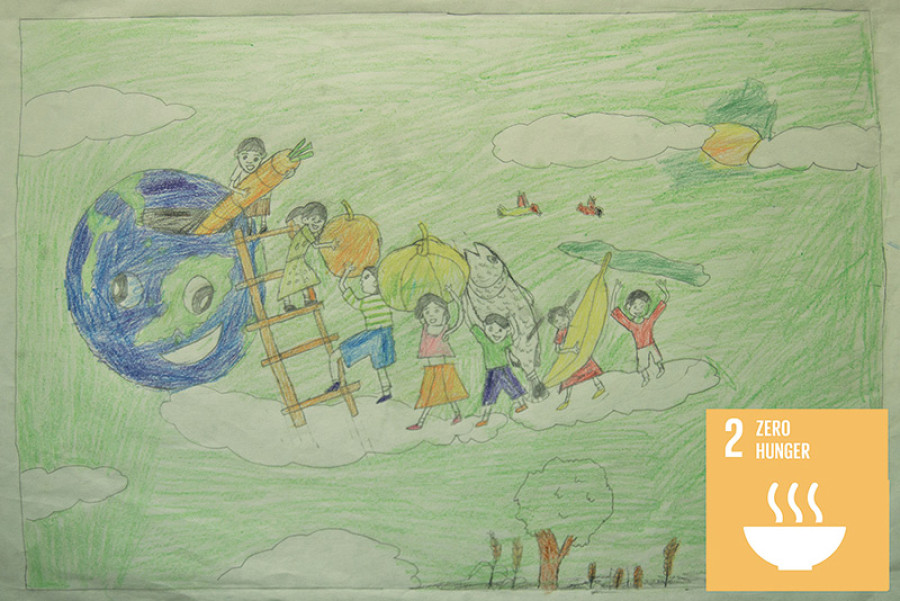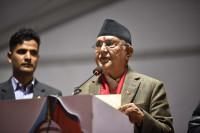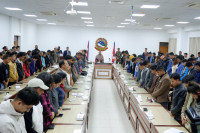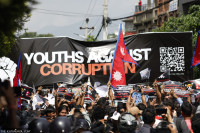Opinion
Together, we can end hunger
Extreme hunger and malnutrition are morally unacceptable. They create a trap from which people cannot easily escape. Hunger and malnutrition mean less productive individuals, who are more prone to disease and often unable to earn more and improve their livelihood.
Basanti Chaudhary
Extreme hunger and malnutrition are morally unacceptable. They create a trap from which people cannot easily escape. Hunger and malnutrition mean less productive individuals, who are more prone to disease and often unable to earn more and improve their livelihood. There are nearly 800 million people, mostly in developing countries, who suffer from hunger. Unless we eliminate hunger, we will not be able to achieve the other sustainable development goals such as education, health and gender equality.
We can make changes in our own lives—at home, at work and in the community—by supporting local farmers or markets and making sustainable food choices, supporting good nutrition for all, and fighting food waste.
Food security
According to the Global Hunger Index (GHI) calculated by the International Food Policy Research Institute (IFPRI), Nepal ranks 58th among 104 countries in terms of its severity of hunger. Though the country has been able to reduce its severity of hunger between 1990 and 2015, it is still at a “serious” level, heading closer to the “moderate” stage.
In Nepal, although improvements are seen, undernourishment remains a significant challenge. In 2011, the proportion of underweight, stunted and wasted children (less than five years) was recorded to be 31, 42 and 14 percent respectively (NPC—NLSS 2010/2011). In 2015, statistics show that 30.1 percent of children (below five years) are underweight, 37.4 percent stunted and 11.3 percent wasted (ADS Updated data—Ministry of Agriculture Development).
The Government’s Periodic Plans, the Agriculture Perspective Plan (1995-2015) and the Agriculture Policy (2004) have certainly contributed to the improvement of food security. But policies in themselves are not the bottlenecks. Problems lie with implementation, lack of coordination, synergy and complementarities among various state and non-state actors. Some of the recently introduced policies and strategies listed below may further enable the government to address the issues related to agricultural growth that can contribute to food and nutrition security—the major focus of SDG Goal 2—provided they are implemented in a coordinated and synergistic manner. These include the Agriculture Development Strategy (2015- 2035), the Food and Nutrition Security Plan of Action (2016) and the Zero Hunger Challenge—National Action Plan (2016-2025).
National plan of action
The Sustainable Development Goals (SDG) are important to me personally —and indeed to all Nepalis—because Nepal is a developing country where almost 22 percent of the population lives below the poverty line. Many people from poor and vulnerable communities are suffering from hunger and food insufficiency. Although Nepal is an agricultural country, its agriculture based production is traditional and not efficient enough. As a result, poor people are becoming poorer day by day.
This may particularly be a problem for ex-bonded labourers such as the Haliyas and ex-Kamaiyas. Although they survive through agriculture-based livelihood, they are unable to go beyond a subsistence level because they have insufficient land, and have no access to natural resources. SDG Goal 2 on eliminating hunger is therefore very important to me. People belonging to my community—I was born in an ex-Kamaiya family—have very low development indicators, and suffer from chronic malnutrition, among other problems.
If Nepal is to progress towards achieving this sustainable development goal, I believe certain key actions are necessary. A national plan of action of the government to achieve SDG Goal 2 is necessary. This will not only ensure its effective implementation, but also facilitate the overall development of the country and the wellbeing of the people. This action plan needs to take into account particularly those people who are living under difficult conditions and surviving through subsistence agriculture.
We also need to focus on empowering poor and oppressed communities, which include people such as the ex-bonded labourers, as well as Dalits and vulnerable women. Human rights must be placed at the centre of these interventions, and must be mainstreamed into relevant plans and policies. Rehabilitation of ex-bonded labourers should be taken into account so as to improve their socio-economic status.
Additionally, our country must place a strong emphasis on taking care of our natural resources. Protecting our natural environment while expanding and modernising our agricultural system should be a priority.
Interrelated goals
In this way, the SDG focusing on hunger is interrelated with the SDGs focusing on the environment and climate change. It is fundamentally about making the most of our natural resources while also taking care of them for future generations.
The SDG Goal 2—zero hunger—is also closely linked with other SDGs. In fact, all 17 are closely interrelated with each other. A person who is hungry or malnourished is not getting adequate nutrition, and may be susceptible to illness and disease, and will not be as productive in the workforce. Children who are not getting enough quality food will also not be able to concentrate in school, and will therefore not reap the benefits of education.
As a natural extension of these factors, hunger has a profound impact on the economy at large. A hungry person simply cannot contribute as much to their family and community as a person who is nourished and healthy. It is therefore a natural conclusion that hunger and malnutrition hamper the overall development of the country. Sufficient food is a necessity for the welfare of society and for the progress of the nation.
Chaudhary, who is championing the rights of Nepali women coming from marginalised and excluded communities, is the winner of N-Peace Award 2016. This is part of a weekly article series on SDGs.




 8.12°C Kathmandu
8.12°C Kathmandu










